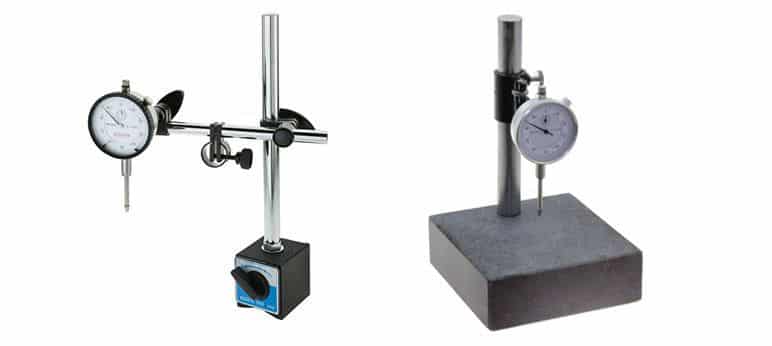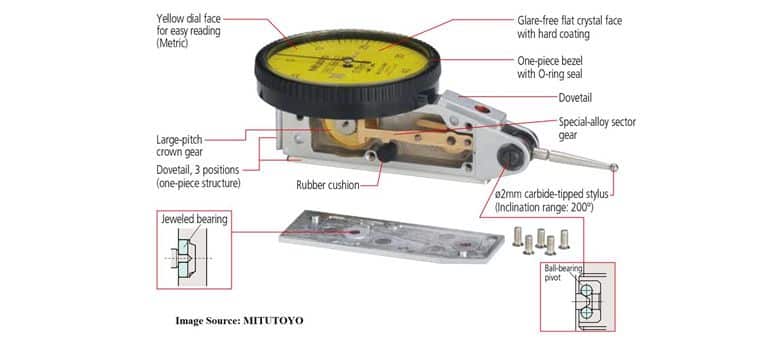1. Introduction to Dial Gauges Calibration
Dial gauges are familiar devices in the fields of mechanical processing and construction. These instruments are used to inspect height, thickness, and runout of components. They can be flexibly combined with other tools such as height gauges, granite plates, magnetic bases, centering devices, and more. To ensure accuracy, periodic dial gauges calibration is essential.
2. Types of Dial Gauges
Standard Dial Gauges: The measuring tip and shaft can move up or down, with graduations ranging from 0.002mm to 0.01mm and measuring ranges of 0-1mm, 0-5mm, or 0-10mm. Lever-Type Dial Gauges: This type uses a lever mechanism to amplify the movement of the measuring tip. It has a small measuring range (usually below 1mm) but offers higher resolution: 1µm, 2µm, or 5µm. Large Dial Gauges: Similar to standard dial gauges but with a larger measuring range of 20mm to 100mm and graduations starting from 0.01mm.
2.1 Standard Dial Gauges
Structure and Operation: A standard dial gauge consists of several parts: a dial face, locking screw, bezel, handle, revolution counter hand, measuring stem, measuring tip, guide sleeve, and other components. The long hand indicates fine measurements, while the short hand shows coarse measurements. When the measuring tip moves, a gear mechanism amplifies the movement and displays the result on the dial. Usage: The device is mounted on a granite plate or magnetic base. The measuring tip is placed against the reference surface, and the dial is set to zero. The part to be measured is then positioned, and the tip is gently placed on it. The reading is taken by observing the long and short hands of the dial. The reference surface can be a granite plate, a gauge block, or a specific position on the part being compared. For example, if the dial shows the long hand at 10 after two full revolutions and the short hand at 1, the result is calculated as: 1mm + 10 × 0.01mm = 1.10mm. 
2.2 Lever-Type Dial Gauges
Structure and Operation: Lever-type dial gauges operate based on the lever principle, consisting of a measuring tip and a gear mechanism that amplifies the movement into a readable value on the dial. These gauges have a mounting shank that fits various holders such as magnetic bases, granite plates, or height gauges.  Usage: The gauge is mounted on a magnetic base or height gauge using the shank. The measuring tip is placed on the part to be inspected, ensuring the angle between the measuring tip and the reference surface is no more than 5°. The dial is set to zero, and the part is rotated or flattened using the height gauge to determine the maximum deviation. For large angles (θ), a compensation factor must be applied to the measured result. For example, if the measured result is 0.200mm:
Usage: The gauge is mounted on a magnetic base or height gauge using the shank. The measuring tip is placed on the part to be inspected, ensuring the angle between the measuring tip and the reference surface is no more than 5°. The dial is set to zero, and the part is rotated or flattened using the height gauge to determine the maximum deviation. For large angles (θ), a compensation factor must be applied to the measured result. For example, if the measured result is 0.200mm:
- At θ = 10°, compensation factor = 0.98:0.200 × 0.98 = 0.196mm
- At θ = 20°, compensation factor = 0.94:0.200 × 0.94 = 0.188mm
- At θ = 30°, compensation factor = 0.86:0.200 × 0.86 = 0.172mm
Note: Compensation factors are referenced from MITUTOYO.
3. Measurement Methods
Comparative Measurement: The measuring tip is placed on the part’s surface to be compared. The dial is set to zero, and another point is measured to determine the deviation. This method reduces errors caused by environmental factors such as temperature, measurement force, assembly errors, manufacturing errors, and human observation errors. Absolute Measurement: The measuring tip is placed on a surface plate, and the dial is set to zero. The part is then measured directly. The dial reading gives the absolute dimension of the part.
4. Why Calibrate Dial Gauges?
Dial gauges are frequently used in industries for detailed measurements. Since they are often used continuously and require high precision, periodic dial gauges calibration is essential to ensure accuracy, maintain work quality, and monitor product quality.
5. Dial Gauges Calibration Procedure
5.1 Calibration Steps
- External Inspection
- Technical Inspection and Measurement Force Check
- Dimensional Accuracy Check: Including total error, partial error, repeatability, and backlash checks.
5.2 Environmental Conditions
Ensure the following conditions during calibration: For gauges with graduations of 0.001mm and 0.002mm:
- Temperature: (20 ± 3)°C
- Humidity: (50 ± 15)% RH
For gauges with graduations of 0.01mm:
- Temperature: (20 ± 8)°C
- Humidity: (50 ± 20)% RH
5.3 Calibration Equipment
- Gauge blocks
- Dial gauge stands
- Force measuring devices with a resolution of ≤ 0.02N or spring scales with a resolution of ≤ 2g
5.4 Calibration Process
Note: This procedure follows general standards and may vary depending on customer requirements.
5.4.1 External Inspection
Visually inspect using the naked eye and a magnifying glass according to the following criteria:
- The brand on the dial must indicate:
- Graduation value
- Measuring range
- Instrument serial number
- Graduations and numbers must be clearly and uniformly engraved. The dial face must be securely positioned, and movement must not affect the indicator needle.
- The glass must be transparent, free from cracks or scratches that could impair readability.
- The width of the long needle must not exceed the width of the graduation marks. The needle must overlap the graduations by 1/3 to 3/4 of their length. In a free state, the needle should rest to the left of the vertical axis by 10 to 30 graduation marks.
- The measuring tip must be free from rust, dents, or scratches.
5.4.2 Technical and Measurement Force Checks
5.4.2.1 Technical Inspection
Use a dial gauge stand to check the movement of the measuring tip according to the following requirements:
- The measuring stem must move smoothly across the entire measuring range without jerking. After releasing the force applied to the measuring tip, the needle must return to its initial position.
- For gauges with a short hand indicating full revolutions of the long hand, the short hand must move smoothly and correspond to the long hand’s movement.
5.4.2.2 Measurement Force Check
- Requirements:
- The measurement force must be between 0.4N and 2.5N.
- The difference between the maximum and minimum measurement forces when the tip moves in and out must not exceed 1.5N.
- The difference in force at any position within the measuring range must not exceed 0.9N.
- Method: Attach the gauge to a stand and place the measuring tip on a scale. Move the stand downward and record the forces corresponding to 5-10 evenly distributed positions within the gauge’s range. Repeat in the opposite direction and note the differences.
5.4.3 Dimensional Accuracy Check
5.4.3.1 General Requirements
- Determine total error and partial error.
- Total error is the maximum difference between the gauge reading and the actual value at any measuring point.
- Partial error is the largest difference between two deviations when checking the gauge at two points spaced 1/10 of a revolution apart.
5.4.3.2 Method 1
Check using a dial gauge tester:
- Attach the gauge according to the tester’s instructions.
- Set the tester to zero corresponding to the gauge’s zero point.
- Gradually move the tester through increments of 1/10 revolution up to 1/5 of the measuring range, then in increments of 1/2 revolution up to half the range, and finally in full revolutions to the end. Record the gauge readings at each step.
5.4.3.3 Method 2
Check using a micrometer or length measuring machine:
- Attach the micrometer to a universal stand.
- Remove the fixed anvil of the micrometer and mount the gauge.
- Follow the same steps as Method 1.
5.4.3.4 Backlash
Backlash is the maximum difference between two measurements at the same point when the measuring tip moves in and out.
5.4.3.5 Repeatability
Repeatability is the maximum difference between repeated measurements at the same point. Method:
- Place gauge blocks on a measuring surface.
- Mount the gauge and lower the tip onto the block.
- Move the tip up and down 10-15 times and record the readings.
